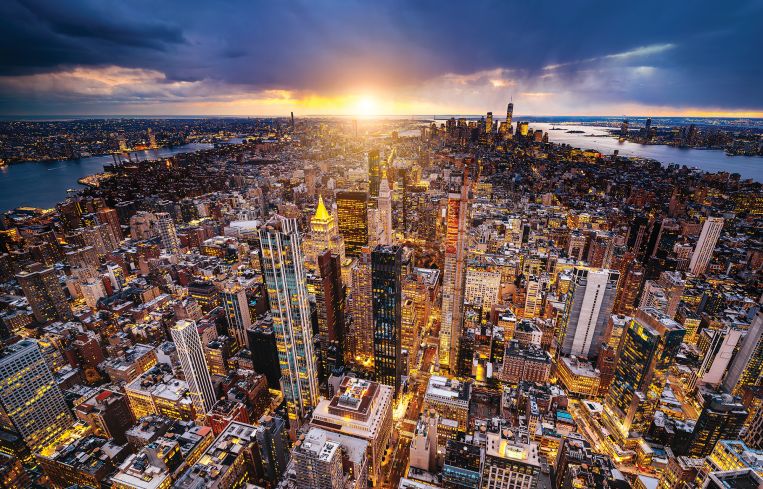Midtown South’s Office Market Rebounds Behind Conversions, New Demand
The submarket’s availability rate is trending downward as its rents best pre-pandemic highs
By Amanda Schiavo September 2, 2025 6:00 am
reprints
Following a pandemic-era slump that hit office leasing activity in Midtown South like a fist to the throat, this trendy swath of Manhattan that stretches from Canal Street to 32nd Street — the geography depends on whom you ask — is on an upswing, welcoming tenants back into revamped and revitalized buildings.
Midtown South’s office tenant occupancy tumbled when COVID-19 struck New York City in early 2020, forcing people to stay home and away from their friends, families and coworkers. By the end of the fourth quarter of 2022, the office availability rate in Midtown South was 16.9 percent, according to Colliers data. Yet prior to the outbreak — in the second quarter of 2019 to be exact — the area’s availability rate hit a three-year low of 8 percent, according to Newmark data.
Now, thanks to greater investments in building improvements by landlords to make them more attractive to tenants, a desire among employers to return to the office and rezoning efforts by the city, Midtown South is in the midst of a resurgence.
“During COVID, Midtown South was the slowest to get back on its feet because the tech tenants were more apprehensive about how they were going to come back into the office,” said David Falk, the president of the New York tri-state region at Newmark. “Toward the end of COVID we started seeing these companies get clarity on the importance of being back in the office, and it was important for them to find buildings that spoke to who they are as a brand.”
As the return to office got underway, landlord investments in refurbishing their buildings began to pay off.
“When people started touring Midtown South they saw buildings like 122 Fifth Avenue — where Microsoft went — which has a new lobby designed by a sophisticated architectural firm, a communal rooftop and a curb appeal that matched an aesthetic for today’s tenant,” Falk said.
Several buildings in Midtown South have undergone or are undergoing renovations to turn into premium office spaces.
West Chelsea’s Terminal Warehouse is being outfitted with a brand-new interior, retail space and massive outdoor public space. To improve employee well-being and productivity, the Starrett-Lehigh Building has been outfitted with amenities, including lounges, podcast studios and a rooftop terrace featuring cabana seating. And 836 Broadway got a soup-to-nuts renovation that included a new lobby with gold archways and custom millwork for more informal meeting areas.
“So you started seeing these buildings that were going to have available space put in a significant amount of money to attract better tenants that would pay higher rents than ever before,” Falk said. “Recently, there’s been a number of signings of tenants who’ve taken bigger space down there.”
In August 2022, banking giant Capital One inked a 116,926-square-foot space at 114 Fifth Avenue, only to expand its lease in February of this year by another 96,606 square feet. In 2023, fashion icon Ralph Lauren renewed its 250,000-square-foot office lease at the Starrett-Lehigh Building at 601 West 26th Street, and, in 2024, tech titan Google renewed its 300,000-square-foot lease at 85 10th Avenue.
So far in 2025 there have been several major leases in Midtown South. These include New York University (NYU) taking a 1.08 million-square-foot lease for student housing at 770 Broadway, Verizon inking a 203,000-square-foot lease at Vornado’s Penn 2 and fintech firm Chime signing an 84,000-square-foot deal at 122 Fifth Avenue.
Additionally, media company Pinterest signed an 83,000-square-foot lease at 11 Madison Avenue. Law firm Goodwin Procter — which is part of a sector that has historically preferred to set up shop in Midtown — signed a 250,000-square-foot lease at 200 Fifth Avenue this year.
“You don’t often see that,” Falk said of the Goodwin Procter lease. “It’s a great, exciting sign of the times [to have] a Midtown law firm [moving to] a beautifully renovated building in Midtown South.”
Overall, office leasing activity in Midtown South is on an upward trajectory, with Colliers’ latest Manhattan market report showing the sector’s leasing volume rising 42.4 percent from June to July, and nearly doubling year over year at 1.32 million square feet.
Rent in Midtown South has also risen since the pandemic. The average asking rent in Midtown South was $75.14 per square foot in the first quarter of 2019, according to Newmark data. The average asking rent in Midtown South for the second quarter of 2025 was $83.28 per square foot.
“There’s just no question that we have come out of the pandemic trough, and all the key indices — leasing activity, availability rate and so on — indicate a recovery,” said Michael Cohen, the president of the tri-state region at Colliers and an office owner through his principal role at Williams Equities. “And the anecdotal evidence that the industries that favor Midtown South have begun to expand again is overwhelming.”
Industries that have historically been drawn to Midtown South are the technology, advertising, media and information sectors, or TAMI, while the financial, insurance and real estate sectors (FIRE) and the legal field have tended to favor Midtown.
Some of the recent TAMI leases in Midtown South include Pinterest, Chime and OpenAI, the creator of ChatGPT, which signed a 90,000-square-foot lease at 295 Lafayette Street late last year. In June, Samsung doubled its footprint to 71,000 square feet at Penn 1.
By the end of the second quarter of 2025, the availability rate in Midtown South tightened with positive absorption, according to Colliers’ data. At 3.9 million square feet, leasing demand in the second quarter of 2025 for Midtown South was 26.1 percent higher than the same quarter for the year prior.
This was Midtown South’s strongest period since the 2019 fourth quarter, and the strength was driven largely by the massive NYU deal, which accounted for 25 percent of the total demand, the Colliers data showed. As a result of the NYU lease, the public sector — which, per Colliers, includes education, government and nonprofits — accounted for the largest share of the quarter’s office leasing activity in Midtown South at 36 percent, while the TAMI sector followed with a 22 percent share thanks to the Pinterest and Samsung leases.
Another factor driving the tightening of availability in Midtown South is the growing trend of office-to-residential conversions. Since the beginning of 2021, Colliers has tracked almost 9 million square feet of space that have come off the market in New York City as a whole due to planned conversions.
“Is Midtown South part of that equation? Yes, absolutely,” said Frank Wallach, the executive managing director for research and business development at Colliers. “In previous market cycles, it was much more or almost exclusively a Lower Manhattan story. But, yes, Midtown South is very much part of that conversation with conversions.”
Arguably the most famous planned conversion in Midtown South is that of the Flatiron Building.
The 123-year-old building that once spanned 204,593 square feet of office space will transform into 60 luxury condominium units. The conversion is part of a joint venture between The Brodsky Organization, GFP Real Estate and The Sorgente Group. Construction on the project is expected to be completed in 2026.
Between 2021 and 2025, 11 Manhattan buildings totaling 3.7 million square feet were converted from office to residential, according to Newmark research. Currently, 12 buildings are undergoing residential conversions, totaling 3.8 million square feet, and the owners of an additional 35 buildings have filed permits for or announced plans to convert an additional 10.6 million square feet.
And there are likely a lot more conversions to come, thanks to recently passed rezoning legislation known as the Midtown South Mixed Use Plan (MSMX). The 42-block plan focuses on areas where housing was typically not permitted due to old zoning rules as part of the city’s wider effort to curb its housing crisis. That wider zoning effort, known as City of Yes, passed the City Council in December 2024.
“MSMX is the first major housing-focused rezoning in New York City that takes advantage of the changes that City of Yes put into place, and it makes a big step forward in tackling the affordable housing crisis,” Councilmember Keith Powers, whose district includes parts of Midtown South, said in a statement. “We are transforming Midtown South into a vibrant live-work neighborhood, alongside historic community investments in schools, transit, parks and more.”
MSMX aims to bring 9,500 new homes to Midtown South, with more than 2,800 of those designated as permanently affordable, the statement said. The new units will be created from an increase in the allowable floor plate ratio (FAR), which calculates how much vertical floor space can be built in relation to the size of a building’s lot.
“The Midtown South rezoning is going to take some more of the inferior office buildings and convert them to residential, especially in areas that can use more street activity [like] the Garment Area or West Chelsea,” Falk said. “This could add between 8,000 and 10,000 new apartments.”
At the moment, Midtown South is in its glow-up era, on the cusp of becoming more of a 24/7 live, work and entertainment district, thanks to a leaner, more competitive office market and city administration initiatives.
“When COVID happened, this area was hit the hardest,” Falk said. “But, now, it’s really exciting to see the wind at its back and to see the amount of tenants who are looking down there and who are growing down there.”
Amanda Schiavo can be reached at aschiavo@commercialobserver.com.



